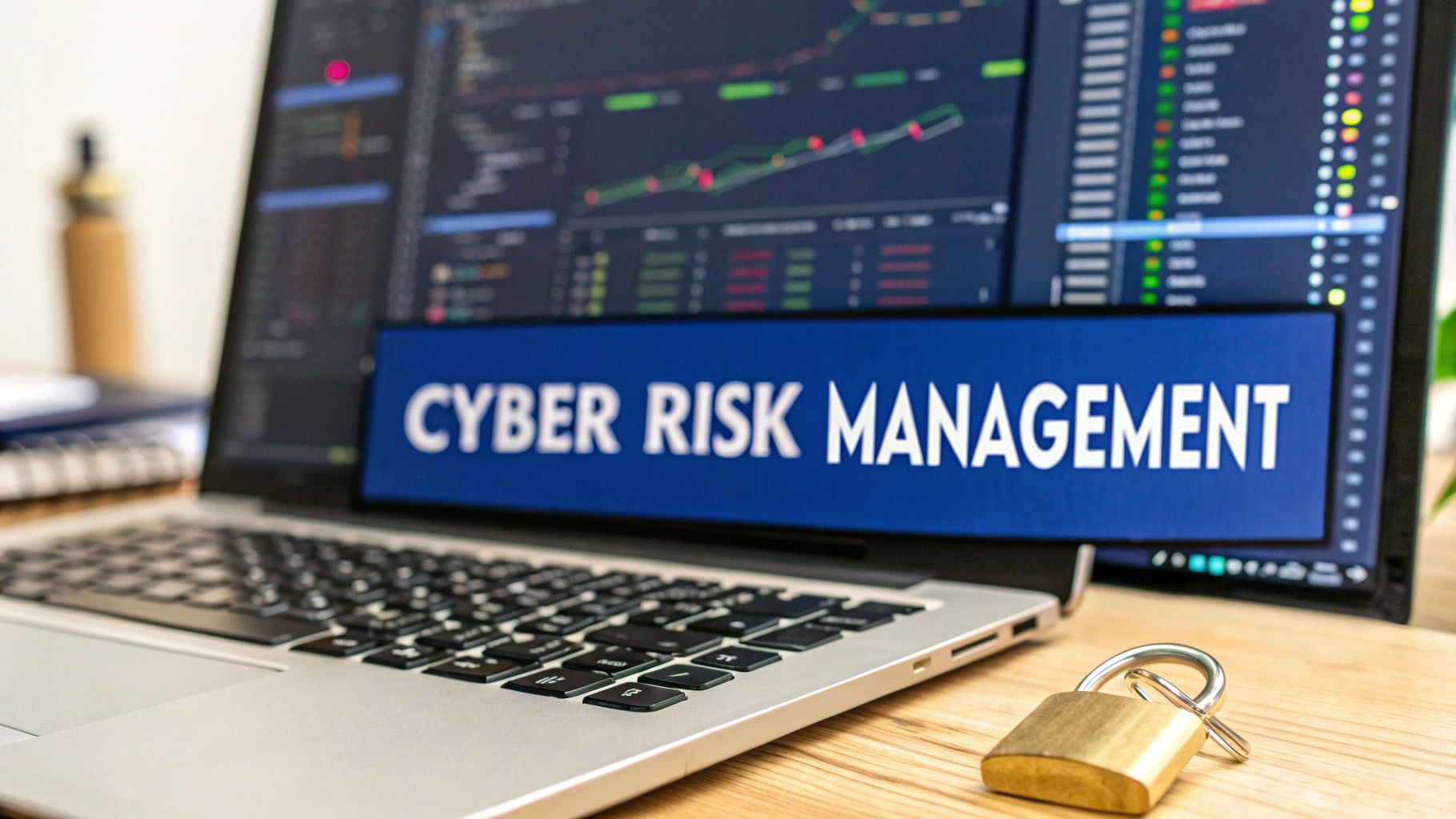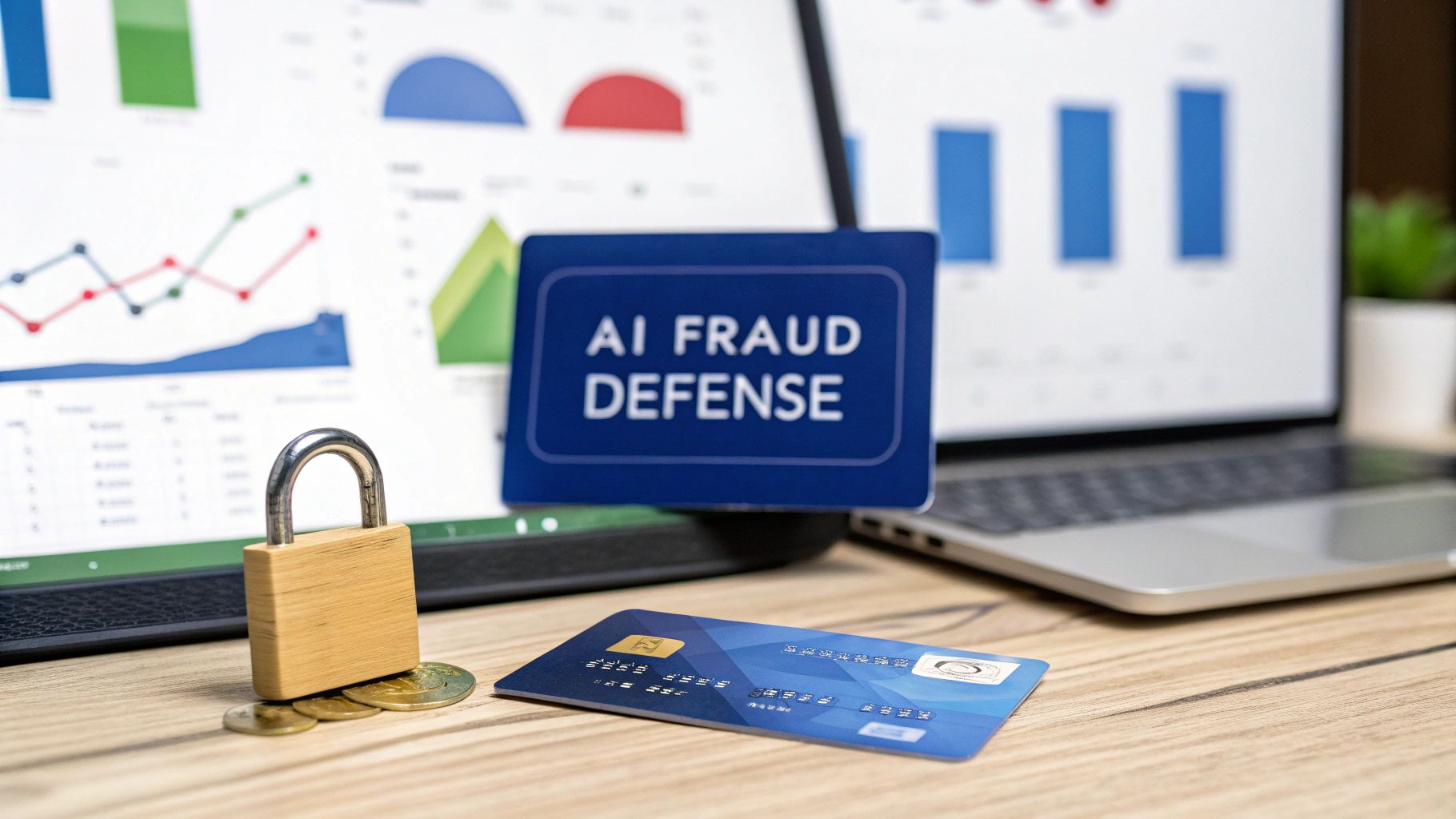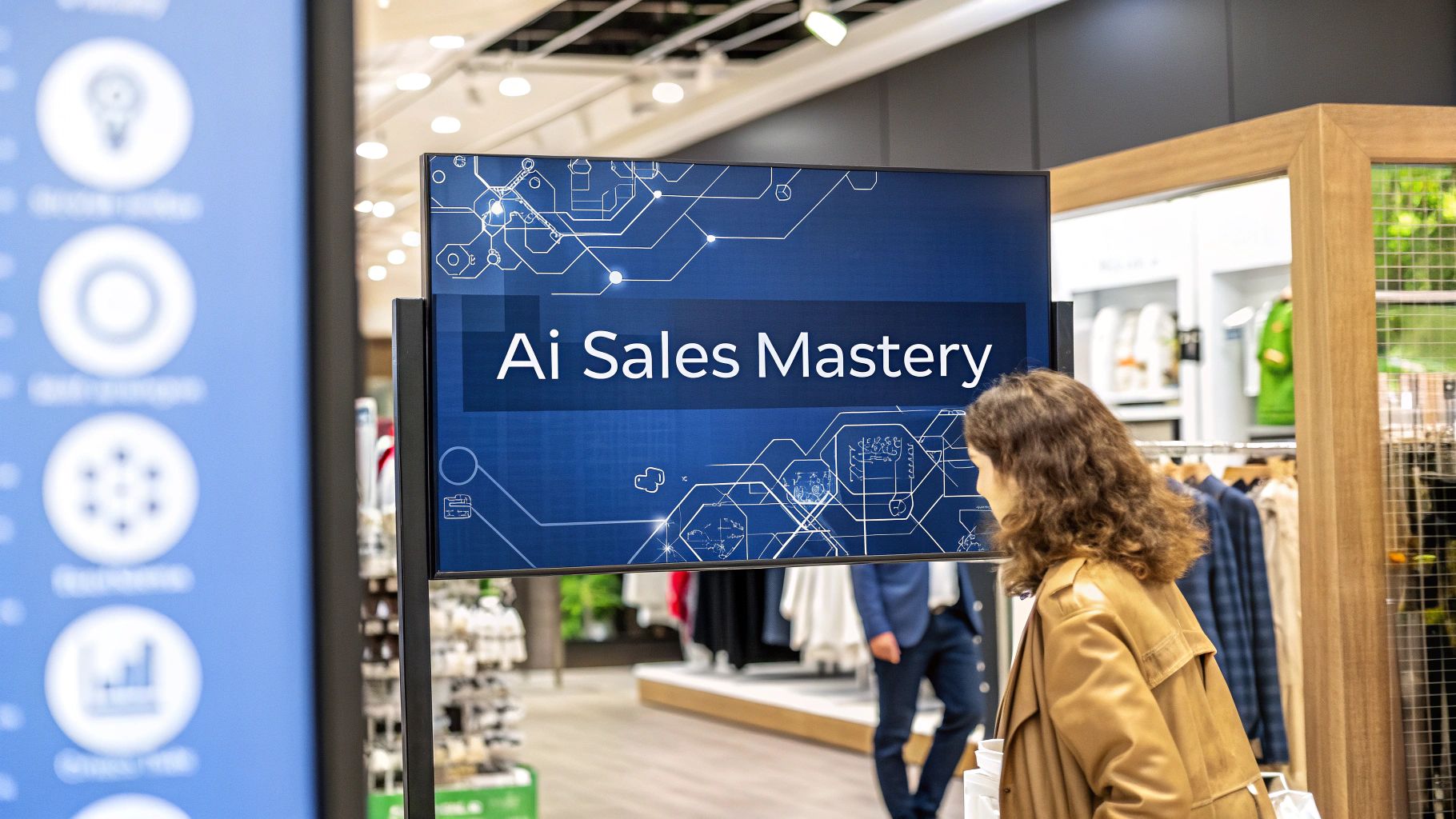Cybersecurity for your business isn’t just an IT problem to be solved; it’s a core part of your overall business strategy. It means weaving together your tech defences with a smart, proactive assessment of potential threats.
Think of it this way: you don't just build walls and hope for the best. You need to understand who might try to climb them and why. A truly successful approach matches your security spending to genuine business risks, making sure your protection is both effective and efficient.
Why Cyber Security and Risk Management are Inseparable

Imagine your company’s digital assets are a treasure vault. Just installing a thicker steel door, ie, the technology part, isn't a complete security plan. You also need a strategy to identify potential thieves, patrol the grounds, and have a clear plan for what to do if someone actually breaks in. That's the heart of risk management, and it’s what turns reactive security fixes into a proactive defence.
For any modern business to survive, these two disciplines have to be deeply connected. It's about moving beyond simply buying the latest security software and making a fundamental strategic shift. When you start looking at cybersecurity through a risk management lens, it stops being a siloed IT issue and becomes a central business function, just as vital as finance or operations.
From a Technical Problem to a Business Strategy
This shift in perspective is everything. A purely tech-focused approach asks, "What firewall should we buy?" An integrated risk management approach asks a much better question: "What are our most valuable digital assets, what are the most likely threats to them, and what’s the most cost-effective way to protect them?"
Aligning your strategy this way brings some serious benefits:
-
Informed Decision-Making: You can put your security budget where it will have the biggest impact, protecting what truly matters instead of spending on tools that don't address your specific weak spots.
-
Proactive Defence: It helps you anticipate threats based on your unique business context, rather than just reacting after an attack has already done its damage.
-
Operational Resilience: By planning for potential breaches ahead of time, you can create solid response and recovery plans that minimize downtime and financial loss.
Viewing cybersecurity as a key part of your company's overall risk management, right alongside financial and reputational risks, is the mark of a mature defence strategy. It ensures your security efforts are directly supporting and protecting your main business goals.
Ultimately, this integrated approach helps you make smarter decisions that protect your operations, reputation, and bottom line. To really get a handle on the stakes, it's worth understanding why businesses should prioritize cybercrime awareness and the profound impact it has on companies of all sizes. The connection is crystal clear: effective cybersecurity for business and risk management isn’t optional; it’s the foundation of lasting success.
Decoding the Modern Business Threat Landscape
If you want to get cybersecurity and risk management right, you first need a clear picture of what you’re up against. The modern threat landscape is a lot more than just “hackers.” It’s a sophisticated and ever-changing environment where attackers blend technical wizardry with psychological tricks to poke holes in your everyday operations.
These threats aren't just abstract ideas; they're real risks with very real consequences. Picture this: an employee gets a seemingly harmless email from a supplier they trust. One click later, your entire company network is locked down, and a ransom demand is blinking on every screen. This is what a ransomware attack looks like today.
Common Attack Vectors Unpacked
Attackers have a well-worn playbook, with each tactic designed to exploit a different weakness. Learning these methods is the first step toward building a solid defence. The real goal is to start thinking like an attacker and see your own business through their eyes, spotting the weak points they’d be most likely to hit.
Here are a few of the most common threats you’ll see out in the wild:
-
Sophisticated Phishing Campaigns: Forget the old, poorly spelled emails. Today’s phishing attacks are hyper-personalized. They often impersonate senior leaders or key vendors to dupe employees into handing over login details or even wiring money.
-
Crippling Ransomware Attacks: This is the digital equivalent of kidnapping. Malicious software scrambles all your critical data, holding it hostage until you pay a ransom. The fallout can shut down your operations for days or even weeks, leading to devastating financial and reputational harm.
-
Insidious Insider Threats: Not every threat comes from the outside. An employee with access to sensitive systems, whether they’re acting maliciously or just made an honest mistake, can cause incredible damage by leaking data or creating security gaps.
These attacks often succeed not because of some brilliant technological failure, but because they prey on human behaviour and slip through cracks in your processes. For a deeper dive into how these digital threats are evolving, check out our guide on current cybersecurity trends. This really drives home why a formal risk management framework is no longer optional.
The Human Element and Supply Chain Risks
Attackers are smart. They know that people are often the most vulnerable part of any security system. A cleverly worded email or a convincing phone call can sidestep millions of dollars in security tech. This is precisely why training your team to be vigilant is such a cornerstone of any good cybersecurity for business and risk management plan.
On top of that, your company's security is only as strong as your weakest partner’s. A breach can easily start with a third-party vendor or a cloud service provider who has legitimate access to your systems. This web of connections stretches your potential attack surface far beyond your own office walls.
Recognizing and dealing with vulnerabilities in outdated systems is a massive piece of this puzzle. You can learn more about how to safely manage legacy data storage and why it's such a big risk.
The global nature of cyber threats means no one is safe. Take the Caribbean, for example, where businesses face an incredibly high risk, dealing with roughly 2,582 cyber-attacks every week. That’s a staggering 40% higher than the global average. In one case, a ransomware attack on a resort group didn't hit the resort directly. Instead, it came through their booking platform provider, freezing everything from electronic door locks to payment systems and causing complete operational chaos for days. You can find more details on the cyber threats facing the Caribbean's vital tourism sector on symptai.com.
This incident is a perfect illustration of how a weakness in a trusted partner's system can bring your own business to its knees. It highlights the urgent need for security measures that account for every single connection your business depends on, proving that risk management is absolutely non-negotiable for survival today.
Building Your Risk Management Framework Step by Step
Knowing the threats is one thing, but organising your defences is a completely different ball game. To move from simple awareness to effective action, you need a clear blueprint. That’s exactly what a risk management framework provides.
Think of it as the architectural plan for your company’s cyber defence. It ensures every security measure is placed intentionally and supports the whole structure, rather than just being a random collection of tools.
A disjointed approach – a firewall here, some antivirus software there – leaves dangerous gaps. A structured framework, on the other hand, helps you build a cohesive, multi-layered defence. We'll use the globally-recognised NIST Cybersecurity Framework as our guide, breaking the process down into five logical functions: Identify, Protect, Detect, Respond, and Recover.
This methodical approach turns the huge task of cybersecurity for business and risk management into a manageable, step-by-step process.
The Five Core Functions of a Cyber Security Framework
This table breaks down the essential stages of a robust cybersecurity risk management framework, explaining the purpose and key activities for each function.
|
Framework Function |
Core Purpose |
Example Activities |
|---|---|---|
|
Identify |
Understand your business context, assets, and risks to prioritise security efforts. |
Asset inventory, risk assessments, and defining governance policies. |
|
Protect |
Implement safeguards to prevent or limit the impact of a potential security event. |
Access control, employee security training, and data encryption. |
|
Detect |
Develop and implement activities to identify the occurrence of a security event. |
Continuous monitoring, security event analysis, and intrusion detection. |
|
Respond |
Take action once a security incident has been detected to contain its impact. |
Incident response planning, communications, and mitigation. |
|
Recover |
Develop plans for resilience and restore any capabilities impaired by an incident. |
Restoration planning, disaster recovery drills, public relations. |
By following these five functions, you create a complete lifecycle for managing cybersecurity risk, from preparation to recovery.
Identify: Know What You're Protecting
You can't protect what you don't know you have. Simple as that. The very first step is to take a complete inventory of your entire digital environment; all your hardware, software, and, most importantly, your data.
But it’s not just about making a list. The real key is to figure out which of these assets are most critical to your business. Ask yourself: what data, if stolen, would cause the most damage? Which systems, if they went offline, would grind our business to a halt? Answering these questions helps you focus your protection efforts where they matter most.
Protect: Build Your Digital Fortress
Once you know what needs protecting, you can start building the defences. The "Protect" function is all about implementing safeguards to stop a security incident from happening in the first place. This is where many of your foundational security controls come into play.
These safeguards are a mix of technology, processes, and people-centric strategies:
-
Access Control: This is about enforcing the principle of least privilege. It just means employees only have access to the data and systems they absolutely need to do their jobs, and nothing more.
-
Employee Training: Your team can be your strongest defence or your weakest link. Regular training on spotting phishing emails, using strong passwords, and following security best practices helps create a "human firewall."
-
Data Security: This involves using tools like encryption to shield sensitive data, both when it's sitting on a server (at rest) and when it's moving across the network (in transit).
Detect: Spot Intruders Early
Let's be realistic: no defence is impenetrable. The "Detect" function works on the assumption that an attacker might eventually get past your initial protections. Its entire purpose is to spot unusual or malicious activity as quickly as possible to minimise the damage. Early detection is everything.
Effective detection means keeping a constant watch over your networks and systems. This is often done with tools like Security Information and Event Management (SIEM) systems, which gather and analyse log data from across your environment to flag suspicious patterns that a human might miss.
The infographic below shows how implementing proactive strategies, like those in the "Protect" and "Detect" phases, is a core part of securing modern business infrastructure.

It’s a great visual reminder that defence is an active, ongoing process—not a one-time setup.
Respond and Recover: Have a Battle Plan
When an incident is detected, the worst thing you can do is panic. The "Respond" and "Recover" functions are about having a pre-defined, well-rehearsed strategy for dealing with a breach and getting back to normal. A clear plan prevents chaos and helps you make smart decisions under pressure.
Your incident response plan should clearly outline:
-
Roles and Responsibilities: Who’s in charge? Who talks to customers? Who handles the technical side?
-
Containment Steps: How do you isolate affected systems to stop the threat from spreading?
-
Eradication and Recovery: How do you remove the threat and restore systems from clean backups to get the business back online?
Crafting these plans is a complex task that often requires deep expertise. For businesses needing guidance, exploring cybersecurity compliance consulting can provide the specialised knowledge needed to create robust, actionable response strategies. This ensures a swift, coordinated effort that can dramatically reduce the financial and reputational fallout from an attack.
The Three Pillars of an Effective Cyber Security Program
A truly resilient security program isn’t something you can just buy off the shelf. It’s built on three interconnected pillars that hold each other up: Technology, People, and Processes. When these three elements are in sync, they create a defence that’s far stronger than any single tool or policy.
Think of it like building a fortress. The high stone walls and heavy gates are your technology. The vigilant guards who patrol those walls and manage the gates are your people. The official rules of engagement, lockdown procedures, and supply chain protocols? Those are your processes. If any one of them fails, the whole fortress is at risk. A strong gate doesn’t matter much if a guard leaves it wide open.
This is the very core of effective cybersecurity for business and risk management. It's all about weaving these three crucial elements into a single, unified strategy.
Pillar One: Technology
Technology is the foundational layer of your defence, acting as the digital walls and moats protecting your most valuable assets. These are the tools that actively block threats, control who gets in, and keep an eye on your environment for anything suspicious. The market is flooded with options, but a few pieces of technology are absolutely non-negotiable for any business today.
Consider these the basic locks on your doors:
-
Multi-Factor Authentication (MFA): This is one of the most powerful yet simple defences you can have. By requiring users to provide a second form of verification, like a code sent to their phone, in addition to their password, you can shut down the vast majority of automated attacks that rely on stolen credentials. It's a massive security upgrade for minimal effort.
-
Endpoint Protection: Every device connected to your network, like laptops, servers, and even mobile phones, is an "endpoint." Each one is a potential doorway for an attacker. Modern endpoint protection platforms go way beyond old-school antivirus to detect and neutralize advanced threats like ransomware and sophisticated malware.
-
Firewalls and Network Security: These are your digital gatekeepers. They stand at the perimeter of your network, inspecting all incoming and outgoing traffic and filtering it based on a set of security rules you define. A well-configured firewall is your first line of defence against intruders trying to get inside.
To truly fortify your digital presence, it's crucial to implement essential website security best practices, forming a robust foundation for your cybersecurity program.
Pillar Two: People
Here’s the thing: technology alone will never be enough. Your employees are the ones interacting with your digital assets every single day. A well-trained team can function as a "human firewall," spotting and flagging threats that technology might otherwise miss. On the flip side, an untrained employee can unknowingly open the gates to an attacker with a single click.
This is where security awareness becomes so important. It isn't about blaming people for making mistakes; it’s about empowering them to be part of the solution.
It's a common myth that cyber attacks are purely technical wizardry. The reality is that a huge percentage of breaches start with a human element, like an employee being tricked into clicking a malicious link in a phishing email.
Regular, engaging security training is the only way forward. This needs to cover the essentials, like how to spot phishing attempts, the importance of using strong and unique passwords, and why data privacy matters. The real goal is to build a security-first culture where every single person on the team feels a sense of ownership in protecting the organisation.
Pillar Three: Processes
Processes are the rulebooks; the documented procedures that govern how your technology and people operate securely. They provide the consistency and structure you need to manage risk, especially when things go wrong. Without clear processes, even the best technology and the most well-meaning people can stumble under pressure.
A few key processes are must-haves:
-
Data Backup and Recovery: This is your ultimate safety net. If you’re hit with a ransomware attack or a catastrophic system failure, having regular, tested backups means you can restore your data and get back to business without paying a ransom or losing everything.
-
Vendor Risk Management: Your security is only as strong as your weakest link, and sometimes that link is a partner or supplier. This process involves carefully vetting the security practices of your third-party vendors to make sure they aren’t accidentally introducing new risks into your world.
-
Incident Response Plan: When a security breach happens, you don't want to be figuring out your game plan on the fly. An incident response plan is your pre-defined battle strategy, outlining the specific steps, roles, and responsibilities needed to contain the threat, minimize the damage, and recover as quickly as possible.
Integrating these three pillars: Technology, People, and Processes, is what it's all about. For those building secure applications from the ground up, understanding key software security best practices offers a deeper look into the technical and procedural controls that make software resilient. By balancing these three pillars, you transform your security from a simple checklist of tools into a dynamic, resilient, and truly effective defence strategy.
Shifting from Reaction to Proaction: A Better Defence Strategy

The best defence isn't about cleaning up a mess; it's about preventing one from happening in the first place. If you're waiting for a security alert to pop up, you're already on the back foot. A truly proactive approach to cyber security for business and risk management requires a mental shift from reacting to breaches to actively hunting for weaknesses and shutting them down before they can be exploited.
This is where the idea of "ethical hacking" becomes so powerful. It involves bringing in trusted experts to do one thing: try to break into your systems. It sounds counterintuitive, but it's a controlled stress test designed to find the cracks in your armour before a real attacker does.
Stress-Testing Your Defences
Two core practices drive this proactive strategy: vulnerability assessments and penetration testing (often called pentesting). They might sound similar, but they play distinct, complementary roles in hardening your security.
A vulnerability assessment is a bit like a thorough building inspection. It uses automated tools to scan your entire network, servers, and applications, generating a detailed report of known security flaws, unpatched software, and configuration errors. Think of it as a broad, systematic health check that flags potential weak spots.
Penetration testing, on the other hand, is like hiring a team of professional lock-pickers to test the building's security. A pentester doesn't just find the vulnerabilities; they actively try to exploit them to see how deep into your systems they can get. This simulated attack gives you priceless, real-world insight into how a genuine breach could play out, often revealing weaknesses in your security policies and response plans that a simple scan would miss.
These simulated attacks are what turn theoretical risks into tangible, actionable data. This is particularly crucial for businesses in rapidly digitizing regions like the Caribbean, where a swift move to the cloud and interconnected supply chains create new, complex vulnerabilities. As a result, many are realising that the strategic need for pentesting in the Caribbean is growing, marking a shift from one-off tests to integrated, ongoing security programs.
Staying Ahead with Continuous Monitoring
A proactive defence isn't a one-and-done event. The threat landscape is in constant flux, with new attack methods and vulnerabilities surfacing almost daily. That's why continuous monitoring and threat intelligence are the keys to long-term resilience.
A strong defensive posture isn't a destination you arrive at; it's a state of constant adaptation and improvement. Your security must evolve at the same pace as the threats you face.
Continuous monitoring means having the tools and processes in place to keep a constant eye on your entire digital environment. The goal is to establish a clear baseline of what "normal" activity looks like, making it far easier to spot anomalies that could signal an attack in progress.
It helps to think of it like this:
-
Threat Intelligence is your early-warning system. It's the process of gathering and analyzing information from global sources about new malware, attacker tactics, and emerging threats. This lets you prepare your defences for attacks you haven't even encountered yet.
-
Continuous Monitoring is your 24/7 security patrol. It's the active, real-time observation of your network, looking for any signs of trouble that demand an immediate response.
By combining proactive testing with relentless vigilance, you build a dynamic security cycle. You test your systems, you fix what you find, and you monitor for new threats. Then you do it all over again. This continuous loop of improvement is what truly allows a business to adapt and maintain a strong, resilient security posture for the long haul.
Stronger Together: Why Collaboration is Your Best Cyber Defence
In today's interconnected world, trying to handle cybersecurity on your own is a losing battle. The idea that a single IT department can fend off every sophisticated threat is simply outdated. Real, effective defence is a team sport, one that requires deep collaboration inside your company and with trusted partners outside of it.
Think of it this way: your IT team might be the architects and engineers of your digital fortress, but they can't build it in a vacuum. They need the legal team to help define the rules of engagement, HR to train the sentries (your employees), and leadership to decide which assets are the most critical to protect. When these groups stop working in silos and start communicating, cybersecurity for business and risk management transforms from an IT problem into a shared company-wide responsibility.
Building Alliances Beyond Your Four Walls
That collaborative spirit shouldn't stop at your company's front door. The most secure businesses know that there's strength in numbers. By sharing intelligence and resources with other organizations, you gain a massive advantage and a much clearer picture of the threats you're all facing.
Some of the most valuable partnerships you can build include:
-
Industry Information Sharing Centres (ISACs): These are fantastic resources. They're essentially neighbourhood watch programs for your specific industry, giving you a heads-up on attacks targeting businesses just like yours.
-
Managed Security Service Providers (MSSPs): Sometimes, it makes sense to bring in the specialists. Partnering with an MSSP gives you access to elite expertise and powerful security tools that might be out of reach for your in-house team alone.
Sharing threat data and best practices isn't just a nice idea, it’s a force multiplier for your defence. This approach creates a more resilient ecosystem for everyone, turning competitors into allies against a common enemy.
This model of cooperation is picking up steam everywhere. A great example is what’s happening in the Caribbean, where nations are banding together to bolster their digital defences. Initiatives like the first Commonwealth Caribbean Cyber Fellowship and the CARICOM Cyber Resilience Strategy 2030 Project show a clear understanding that a united front is the only way to protect a region's digital future. You can read more about these cybersecurity developments and regional collaboration in the Caribbean on cybersecurityadvisors. network.
Common Questions Answered
Diving into cybersecurity and risk management can feel like learning a new language. It’s natural to have questions. Here are straightforward answers to some of the things business leaders often ask as they start building a more secure operation.
Where Should a Small Business Even Start?
For a small business, the sheer volume of security advice can be paralyzing. The best approach? Don’t try to do everything at once. Start with the basics that give you the most bang for your buck.
Focus on what I call the "security essentials." This means setting up multi-factor authentication (MFA) on every important account, creating a rock-solid data backup system you test regularly, and teaching your team how to spot common scams. These first few steps shut the door on the most frequent attacks without breaking the bank.
The aim isn't to become Fort Knox overnight. It's about taking smart, practical steps that make you a less appealing target. Most cybercriminals are looking for an easy win; a few simple defences will encourage them to look elsewhere.
Is Effective Cyber Security Actually Affordable?
Yes, it absolutely can be. While you could spend a fortune on high-end security gear, many of the most powerful security habits are low-cost or even free. The trick is to be smart and strategic with your resources.
Simple things like enforcing strong password rules, keeping your software up-to-date, and turning on MFA cost next to nothing but patch up major security holes. Instead of buying every flashy tool on the market, direct your budget toward the core necessities, think good endpoint protection for your devices, and reliable, tested data backups. A solid cybersecurity and risk management plan is about making shrewd investments, not just expensive ones.
How Do I Measure the Return on My Investment (ROI)?
This is a great question because, with security, you're often measuring a non-event: the expensive data breach that didn't happen. But you can definitely frame the value in a few concrete ways.
First, think of it like business insurance. The cost of just one data breach, factoring in fines, downtime, and the damage to your reputation, can be crippling. For example, the average cost of a healthcare data breach is nearly $10 million. Your security spending is the premium you pay to sidestep that kind of disaster.
You can also watch for improvements in specific areas:
-
Fewer Alarms: A noticeable drop in security alerts and minor incidents.
-
Quicker Fixes: Faster detection and cleanup when an issue does pop up.
-
Easier Compliance: Meeting industry regulations helps you avoid fines and shows customers you're trustworthy.
By keeping an eye on these markers, you can clearly show how your security investments are actively cutting down on real business risks and making your entire operation more resilient.
For businesses wondering where to begin, the journey starts with a few foundational steps. This checklist outlines the initial actions that provide the greatest impact, helping you build a strong security posture from the ground up.
Starting Your Cyber Security Journey: A Quick Checklist
|
Priority Level |
Action Item |
Why It Matters |
|---|---|---|
|
High |
Implement Multi-Factor Authentication (MFA) |
This is your single best defence against stolen passwords, stopping most unauthorized access in its tracks. |
|
High |
Establish Automated & Tested Backups |
Ensures you can recover quickly from a ransomware attack or hardware failure without losing critical data. |
|
High |
Conduct Basic Security Awareness Training |
Your team is your first line of defence. Teaching them to spot phishing emails and scams is crucial. |
|
Medium |
Deploy Endpoint Protection |
Protects employee laptops and devices from malware and viruses, no matter where they are working from. |
|
Medium |
Create a Strong Password Policy |
Simple but effective. Eliminates weak, easily guessed passwords that attackers love to exploit. |
|
Medium |
Keep All Software and Systems Updated |
“Patching” closes security holes that criminals use to get into your network. |
This checklist isn't exhaustive, but tackling these items will put you far ahead of the curve. It's about building momentum and creating a culture of security, one practical step at a time.
Ready to build a resilient and secure future for your business? The team at Cleffex Digital Ltd specialises in creating robust software solutions and security strategies that protect your assets and empower growth. Visit our website to discover how we can help you turn your security challenges into a competitive advantage.








